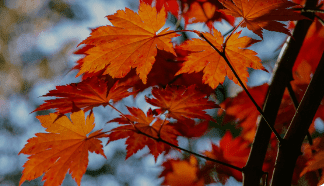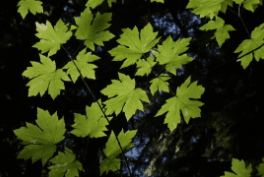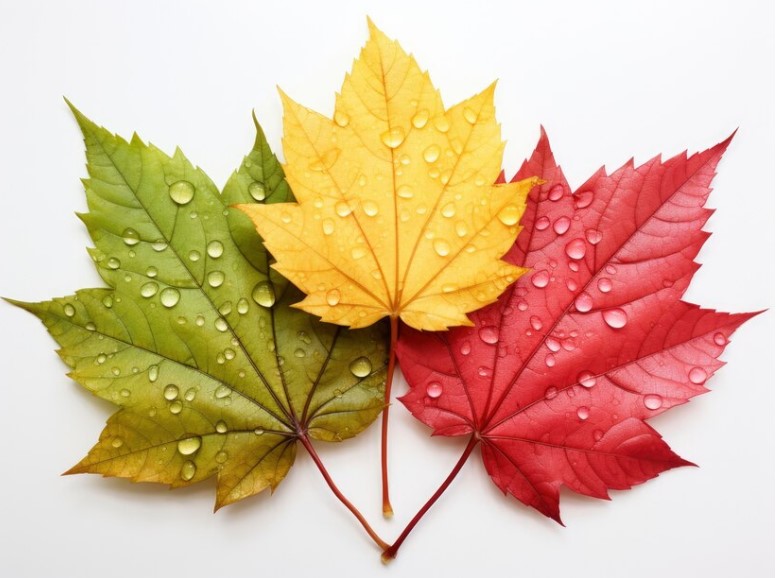The genus Acer includes more than 128 kinds of maple trees around the world, with leaves that come in many shapes and colors. A lot of people know maple trees for their beautiful leaves, which have interesting shapes and bright colors.
The genus Acer includes more than 128 kinds of maple trees around the world, with leaves that come in many shapes and colours. Due to their beautiful looks, these trees are highly valued and are often used for gardening and decoration. Each type of maple trees, from the common sugar maple to the Japanese maple trees, has its own unique look and traits.
No matter what you want, maple trees have a great option for you. They can provide shade, make syrup, or just make your yard look nicer.
Amur Maple (acer Ginnala)
The Acer ginnala, or Amur maple, is a type of maple tree that is popular for gardening because of its bright fall colors and small size. This tough and flexible tree comes from East Asia. Its beautiful flowers make it a popular choice for parks and cities.

The formal name for the Amur Maple is Acer ginnala. It is a small tree that loses its leaves in the autumn and is in the Sapindaceae family. This beautiful tree comes from East Asia and is grown for its ornamental value and ability to survive in harsh circumstances. Let’s talk about some of this species’ most important traits and how to grow it.
- Physical Attributes:
- In general, the Amur Maple grows to be 20 to 30 feet tall and 15 to 20 feet wide.
- It has unique three-lobed leaves that change from bright green in the summer to bright red, orange and yellow in the autumn.
- In the spring, it has small, fragrant, creamy white flowers that turn into pretty red samaras, which make the tree look more interesting.
- Environmental Adaptability:
- This species does well in a range of soil types, from clay to loamy, which means it can survive in a variety of settings..
- Amur Maple trees can survive in USDA zones 3 through 8, can handle extreme cold, and can even handle pollution in cities.
- Cultural Significance:
- It’s often used for gardening in cities and suburbs because it’s small and has a nice canopy.
- The Amur Maple is a popular choice for making hedge rows, privacy screens, and decorative accents in parks because it is easy to work with and doesn’t need much care.
- Growing Tips:
- Plant in dirt that drains well and make sure it gets enough sun for the best growth and coloration of the leaves.
- Regular trimming helps it keep the shape you want and makes it grow more densely.
The Amur Maple is a beautiful tree that can be used in many different ways in settings. This tree comes alive and adds charm to outdoor areas whether it’s planted alone or in a group.
Big Leaf Maple (acer Macrophyllum)
Many people know the Big Leaf Maple, which is properly called Acer macrophyllum. It is the most common type of maple trees. It can be found in the western parts of North America and is known for its big, broad leaves. The wood from this tree is very good and is often used to make furniture and musical instruments because it has beautiful grain patterns.

This type of maple tree grows only in North America. It is well-known for its unique big leaves and beauty as a decorative plant. Let’s look into what makes it special and what it means for the environment.
Description:
- Large Leaves: The Big Leaf Maple is known for having big, wide leaves that can get up to 12 inches across. When fall comes around, these leaves turn bright yellow and gold, making the landscape look beautiful.
- Habitat: You can find this species in low- to mid-elevation woods in the Pacific Northwest, where it does well in the mild and wet weather. It often grows next to well-known evergreen trees like the Douglas fir and the western red cedar.
- Ecological Role: The Big Leaf Maple is an important place for many animal species to live and eat. Its seeds, sap, and protection are important to birds, mammals, and insects, making it an important part of the ecosystems in the area.
Environmental Importance:
- Soil Stabilization: Its large root system helps to stabilise the soil, especially along riverbanks and streambeds, specifically in riparian areas.
- Carbon Sequestration: As with all plants, the Big Leaf Maple is an important part of carbon sequestration, which means that it absorbs and stores carbon dioxide from the air to lessen the effects of climate change.
- Aesthetic Value: In addition to its ecological role, this tree makes its surroundings look better, which adds to the ecosystem’s total biodiversity and beauty.
Cultural Significance:
- Indigenous Uses: Historically, indigenous communities utilized various parts of the Big Leaf Maple, including its wood for crafting tools, baskets, and ceremonial objects, showcasing its cultural and practical significance.
- Modern Applications: In contemporary times, the wood of the Big Leaf Maple is highly prized in craftsmanship, particularly for creating musical instruments, furniture, and decorative items due to its attractive grain patterns and strength.
Conservation Status:
- Current Status: The Big Leaf Maple is not widely endangered, but its habitat is becoming more and more threatened by climate change, urbanisation, and cutting down trees. This shows how important it is to protect its ecological and cultural value.
The Big Leaf Maple is a beloved and important part of North America’s natural settings because of its unique traits and benefits to the environment.
Hedge Maple (acer Campestre)
There is a type of maple trees called Hedge Maple, which is also known as Acer campestre. It grows densely and is not very big. This tree is useful in many situations. It is often used as a fence, and its lobed leaves and yellow-green flowers make it look nice in landscaping.
This type of tree is famous and useful. Because of its unique qualities and ability to adapt, it is a good choice for many planting and gardening projects. No matter how experienced you are with plants or how excited you are about planting for the first time, the Hedge Maple trees are sure to captivate you with its unique traits.
Appearance And Growth
- The Hedge Maple usually gets 25 to 35 feet tall and has a thick, round crown.
- These plants have small, deeply lobed leaves that are bright green in the spring and summer.
- In the fall, the leaves turn a beautiful array of golden-yellow shades, making for a picturesque scene.
Ideal Growing Conditions
- Does best in well-drained soil with a modest amount of water, but once established, it can handle short droughts.
- It does a great job of adapting to different types of soil, such as clay, loamy, and sandy soils.
- It grows well in both full sun and partial shade, which makes it a great choice for a wide range of outdoor settings.
Landscape Applications
- Its thick leaves and slow growth rate make it perfect for making hedges, screens, or even topiaries.
- The Hedge Maple looks great in parks, gardens, and along city streets because it is smaller than most trees.
- Because it is strong and doesn’t mind pollution, it is often used in cityscapes and greening projects.
The Hedge Maple is a great addition to any outdoor place because it looks nice, is easy to care for, and can be used in many different ways in the landscape. The fence Maple is a great tree that will definitely make your outdoor space better, whether you want it as a fence, a screen, or a beautiful ornamental.
Hornbeam Maple (acer Carpinifolium)
The Hornbeam Maple, which is also called Acer carpinifolium, is a type of Maple Tree. This tree is great for adding a touch of natural elegance and beauty to any scene. Its smooth, deep green leaves stand out, and its bark is very smooth.

This beautiful tree from the eastern United States loses its leaves every year.
Characteristics:
- People often mix up this species with the Carpinus because its leaves look a lot like those of that plant.
- • The leaves of the Hornbeam Maple are green with big teeth that turn bright yellow, orange and red in the autumn.
- It grows slowly most of the time, getting 20 to 30 feet tall and 15 to 25 feet wide.
Growing Conditions:
- Does best in acidic, well-drained soils and likes some shade, which makes it a great choice for woodland gardening.
- It doesn’t need much care and doesn’t get infested with pests or diseases.
- This species has a middling ability to handle pollution in cities.
Landscaping Uses:
- The Hornbeam Maple is a great tree for small areas because it is small and has pretty leaves.
- People want to add it to their gardens to make them look nice because of its beautiful autumn colours.
- It is often used as a specimen tree and in urban areas to add a touch of elegance.
The Hornbeam Maple (Acer carpinifolium) is a beautiful tree that goes well in any yard or landscape. It looks great all year and is easy to take care of.
Japanese Maple (acer Palmatum)
Acer palmatum, which is what the Japanese Maple is scientifically called, is a beautiful type of maple tree that people love for its graceful shape and beautiful leaves. People like this tree because it looks nice in parks and landscapes because of its bright red, orange, and gold colours.
The Japanese Maple is a graceful and delicate tree that is known for its beautiful leaves and graceful structure. This tree is very popular as an ornamental in many parks because it comes in many different types and bright colours. Here is a closer look at this beautiful species:
Appearance:
- People love Japanese maple trees for their beautiful palmate leaves that have five to seven separate lobes. The leaves can be bright red, orange, yellow, or green, and they make any scenery look more interesting.
- These trees also have a beautiful, wide canopy that makes any place feel airy and charming.
Cultural Significance:
- In Japan, the Acer palmatum tree is a sign of balance, peace, and calm. It has a lot of meaning in traditional gardens and is often linked to peace and unity.
- The Japanese Maple is often used for bonsai because of its unique leaves, which represent the beauty and balance of nature in a small scale.
Growing Conditions:
- Japanese Maple trees do best in places with some shade, since too much sun can burn the leaves. To grow well, they need grounds that drain well, are slightly acidic, and get regular water.
- This species doesn’t need a lot of care, which makes it a popular choice for farmers who want to add a touch of elegance to their yards without having to do a lot of work.
Landscape Use:
- The Japanese Maple is a beautiful ornamental tree that is often used as a yard focal point or as part of a shrub border to make the plants around it stand out.
- Its small size makes it perfect for small gardens, patio pots, and even bonsai arrangements. It adds a touch of class to any outdoor spot.
The Japanese Maple (Acer palmatum) is a truly amazing plant that makes any scenery more beautiful and peaceful. It has unique leaves, cultural meaning, and many uses, which makes it a perennial favourite among farmers and nature lovers.
Norway Maple (acer Platanoides)
Acer platanoides, or the Norway Maple, is a famous type of maple trees that is loved for its bright leaves and ability to survive in harsh conditions. It is a popular choice for gardening and urban areas because its leaves have unique shapes and it can grow in a wide range of climates.
These are some of the great things about this type of maple tree that have made it famous.
Characteristics Of Norway Maple:
- Large, broad leaves with five lobes: The Norway Maple has big leaves that are usually 4 to 7 inches wide and have five separate lobes that are very deeply cut. This unique leaf form is one of the things that makes the tree unique.
- Yellow-green flowers in clusters: There are small, yellow-green flowers on the Norway Maple tree that grow in groups in the spring. When the tree is in bloom, these groups make it look better.
- Samaras with winged seeds: After the flowers die, the tree makes samaras, which are also called chopper seeds because they look like wings. It is the wind that spreads these seeds, which helps the tree species grow.
Growing Conditions And Maintenance:
- Full sunlight and well-draining soil: Full sun and dirt that doesn’t stay soggy are the best places for Norway Maples to grow. To keep the soil from getting too wet and damaging the tree’s roots, it’s important to have good drainage.
- Regular pruning to maintain shape and structure: The Norway Maple needs to be pruned regularly to keep its healthy, balanced shape. The general look and health of the tree are improved by regular care, like pruning.
Uses And Benefits Of Norway Maple:
- Ornamental tree in landscaping: The Norway Maple is often used as an ornamental tree in landscaping because it looks nice. Its dense leaves turn a beautiful yellow in the fall.
- Shade provider: The Norway Maple’s wide crown makes it a great tree for providing shade, which is very helpful during the hot summer months.
Potential Challenges:
- Invasive tendencies in some regions: The Norway Maple is thought to be invasive in some places because it beats out local species. Before planting this species in certain places, it’s important to think about how it will affect the climate.
With its beautiful leaves, unique seeds, and ability to grow in a variety of landscapes, the Norway Maple is a strong and noticeable addition to any outdoor space. By learning about its unique qualities and how it should grow, you can successfully grow and enjoy this highly regarded maple species.
Paperbark Maple (acer Griseum)
The Acer griseum, which is also called the Paperbark Maple, is a beautiful type of maple tree. People love this one-of-a-kind tree for its peeling bark and bright fall leaves, which make it a good choice for gardening and making gardens and parks more interesting to look at.
People and landscape planners like the Paperbark Maple as an ornamental tree because it grows slowly and is easy to care for.
The Paperbark Maple, whose scientific name is Acer griseum, is a small tree that loses its leaves every fall. Its beautiful cinnamon-colored bark peels and curls, making any scenery look nice all year. This type of tree comes from central China and was brought to the US for the first time in 1901.
Description Of Paperbark Maple:
- Distinctive Bark: It is known that the Paperbark Maple has unique cinnamon-colored bark that peels and curls, making it look beautiful all year long. Because of this one-of-a-kind quality, landscape planners and homeowners who want to add a beautiful focal point to their gardens often choose it.
- Foliage and Autumn Color: The Paperbark Maple has three-lobed leaves that are dark green in the summer and turn bright orange and red in the fall, making a beautiful show of fall colors. This gives the tree yearly interest and makes it a good choice for people who want bright leaves in their yard.
- Compact Size and Growth Habit: The Paperbark Maple can grow up to 30 feet tall and 15 to 25 feet wide, making it a good choice for smaller areas or as a stand-alone tree. Its slow growth rate and small size make it a great choice for landscapes in cities and suburbs where room may be limited.
- Landscape Use: This type of maple tree is often used as a center point in gardens, along paths, or in small groups. Its beautiful bark and leaves make it a great choice for adding texture and visual interest to a wide range of landscaping schemes.
The Paperbark Maple is a unique and beautiful tree that adds interest and beauty to any setting all year long. Its unique features make it a top choice for homeowners and landscape professionals who want to improve the look of outdoor areas. It can be used as a focal point or as part of a bigger design.
Red Maple (acer Rubrum)
Red Maple, which is also called Acer rubrum, is a popular type of maple tree that is loved for its bright red leaves in the fall. It is easy to spot this fast-growing tree because it has red twigs and flowers, which makes it a popular choice for gardening and decoration.
The red maple, or Acer rubrum, is a flexible and easy-to-care-for tree that is often used in gardening and as a shade tree in many places. Let’s look at the red maple tree’s most important traits and features.
Appearance:
- Brilliant Fall Foliage: Red maple trees are famous for their bright red leaves in the fall, which make fields look beautiful. Its leaves change from green to bright red, making a beautiful scene.
- Bark and Branches: When the red maple is young, its bark is smooth and light gray. As the tree ages, it gets rougher. It’s a pretty decorative tree because the branches make a round, symmetrical crown.
Habitat And Growth:
- Native Range: The red maple grows naturally in a wide range of places in Eastern North America. It does well in swamps, upland woods, and soils with different amounts of water.
- Growth Rate: The red maple is known for growing quickly and can reach heights of 40 to 60 feet very quickly. This makes it a great choice for bigger outdoor areas that need shade.
Ecological Importance:
- Wildlife Attraction: Because it has seeds and buds, the red maple is an important food source for many animals, like birds and small mammals.
- Environmental Adaptability: As a hardy plant, the red maple is important for keeping wetland ecosystems stable and can survive in urban environments, which adds to its ecological importance.
With its beautiful look, ability to adjust, and ecological value, the red maple is still a popular choice for both landscapes and natural areas.
Silver Maple (acer Saccharinum)
The scientific name for the Silver Maple is Acer saccharinum. It is a type of maple tree that is known for growing quickly and having leaves that are silver on the back. The Silver Maple is a popular choice for gardening because of its graceful shape and pretty leaves. It adds natural beauty to many outdoor spaces.
This tree grows in Eastern North America and loses its leaves every year. People like this medium- to large-sized tree because it grows quickly, which makes it a great choice for gardening and shade.
- Distinctive Features:
- The tree gets its name from the deep cuts in its leaves that show off their silvery-white undersides.
- A silver maple’s bark is dark and wrinkled, which makes it look nice.
- It makes samaras, which are seeds with wings that are eaten by many kinds of wildlife.
- Adaptability and Growth:
- Silver Maples do best in wet, moist soils, which makes them perfect for low-lying places and areas near water.
- Each year, these trees grow up to three feet taller for every year that goes by.
- They can grow in a lot of different soil types and settings, which makes them a flexible and low-maintenance choice.
- Landscaping and Uses:
- The silver maple is often used as a shade tree in cities and suburbs because it grows quickly and has a wide cover.
- It’s a popular choice for a decorative tree because it looks nice, especially in the fall when the leaves turn bright shades of yellow and red.
- Because it has a fine texture and isn’t too strong, silver maple wood is used to make furniture, shelves, and other woodworking projects.
The silver maple is a beautiful and useful tree that is liked for its ability to adapt to different situations, its fast growth, and its ornamental value. This makes it a popular choice for many gardening and woodworking tasks.
Sugar Maple (acer Saccharum)
The Sugar Maple (Acer saccharum) is a type of maple tree that is famous for its bright fall leaves and for being used to make maple syrup. People value these trees for how hardy they are, and you can find them all over North America. The Sugar Maple is often used for gardening and woodworking because it has unique leaves and thick wood.
This tree is native to North America and is famous for its beautiful fall leaves and useful sap, which is turned into maple sugar. People admire this species of tree for its many qualities and important parts in both natural and man-made settings.
Let’s look into what makes the Sugar Maple special and what it means.
Characteristics Of Sugar Maple:
- Distinctive Leaves: The Sugar Maple has beautiful leaves that look like palms. In the fall, the leaves turn bright shades of yellow, orange, and red. Because its bright leaves make for beautiful fall scenes, the Sugar Maple is a very popular decorative tree.
- Valuable Sap Production: The sap from the Sugar Maple is an important part of making maple syrup, which is renowned for its delicious taste. Because the sap from the Sugar Maple has a lot of sugar in it, it makes delicious syrup that people all over the world love to use in their cooking.
- Long Lifespan: Some Sugar Maple trees have been known to live over 400 years, which is a very long time. They last a very long time, which makes them a good long-term investment for gardening and forestry projects.
- Indispensable Ecosystem Role: As the main canopy species in many deciduous woods, Sugar Maples provide food and shelter for many types of animals, such as birds, mammals, and insects. You can’t say enough good things about how important they are to the health and variety of their natural environments.
Significance Of Sugar Maple:
- Cultural Symbolism: As the state tree of several U.S. states, the Sugar Maple has a special place in the cultural and historical history of North America. Its famous leaf is a big part of the Canadian flag, which shows how important it is to the country.
- Economic Contributions: The Sugar Maple is important to the business because it is used to make and trade maple syrup, which is also important for the environment and culture. A lot of people make a living in this business, and it helps the regional and national economies.
- Landscape Enhancement: Landscapers and homeowners love the Sugar Maple for how it looks and how beautiful it is in different seasons. Its beautiful leaves and graceful shape make it a popular choice for improving outdoor spaces and making residential and business landscapes look better.
As we learn more about the Sugar Maple’s long-lasting appeal and significance, it becomes clear that this famous species has left an indelible mark on both nature and people. The Sugar Maple is still a symbol of strength, abundance, and natural beauty, whether it’s praised for its beauty, its food, or its role in protecting the environment.
Sycamore Maple (acer Pseudoplatanus)
The sycamore maple (Acer pseudoplatanus) is a well-known type of maple tree that is known for its beautiful, wide canopy and leaves that have distinct lobes. It’s a popular choice in both cities and suburbs because it can handle a wide range of soil and weather conditions. This makes it a useful and low-maintenance addition to gardening projects.
This is a big tree from the Sapindaceae family that loses its leaves in the fall. This type of tree comes from central Europe and western Asia, and it is known for being able to thrive in a wide range of circumstances.
Because of its unique qualities and benefits, it is often used for gardening and decoration. Here are some of the most important things about the Sycamore maple:
Unique Characteristics:
- People know sycamore maple trees for their big, wide crown that gives off a lot of shade.
- In the spring and summer, the Sycamore maple’s leaves are bright green and have deep lobes. In the fall, the leaves turn a beautiful yellow color.
- It has groups of small, greenish-yellow flowers, and then it makes samaras, which are fruits with wings.
Adaptability and Growth:
- The Sycamore maple grows well in a wide range of soils and can handle both sun and shade, which makes it a useful plant for landscaping.
- With the right care, this plant can grow very quickly and get over 100 feet tall. Its strong structure and ability to respond make it a great plant for planting in cities.
Landscape Applications:
- As a shade tree, the Sycamore maple is often found in parks, big gardens, and urban areas because of its large size and striking appearance.
- It’s a popular choice for making public and private areas look better because it looks good and doesn’t need much upkeep.
With its unique traits and ability to adjust, the Sycamore maple is a valuable addition to landscaping, providing both beautiful views and useful benefits. The Sycamore maple has always been a popular choice for improving outdoor areas, whether it’s for its beauty or for its benefits to the environment.
Tatarian Maple (acer Tataricum)
The beautiful red leaves of the Tatarian Maple, which is also known as Acer tataricum, make it a well-known type of maple tree. It comes from Europe and Asia and is small to medium-sized. It is highly valued for its beauty in landscaping and yard design.
Overview
This is a small to medium-sized tree that loses its leaves in the fall. It is native to central and southeast Europe and western Asia. People often grow it as a decorative tree because it looks nice and can grow in a wide range of soil types and climates.
Characteristics
- People know the Tatarian Maple for its unique, lobe-shaped leaves that change bright shades of red, orange, and yellow in the fall.
- In the spring, it has small, unnoticeable flowers that are followed by samaras, which are groups of flying seeds.
- This tree usually grows between 15 and 20 feet tall and 15 to 18 feet wide, so it can be used in smaller parks and landscapes.
Growing Conditions
- The best soil for Tatarian Maples is one that drains well, and they like full sun over partial shade.
- They can handle some smog in cities, which makes them a great choice for cities.
- Giving the tree regular watering and fertilizing every once in a while can help it grow well and look better as a decoration.
Landscaping Uses
- Tatarian Maple is often used as a focal point in flower beds or as a specimen tree in residential landscapes because it is small and has beautiful fall foliage.
- It can also be put in groups to make a colorful, natural look in bigger outdoor areas.
Pests And Diseases
• Tatarian Maples are usually resistant to pests and diseases, which makes them easy to care for in gardening projects.
Final Thoughts
With its beautiful leaves and ability to adapt to different conditions, Tatarian Maple is a great choice for homeowners and landscape designers who want to make their outdoor places more interesting to look at and more appealing throughout the year. This tree is both beautiful and strong, and it can be used as a single statement piece or as part of a well-balanced planting scheme.
Vine Leaf Maple (acer Cissifolium)
It is called Acer cissifolium, but the Vine Leaf Maple is its own species. It is known for its delicate, vine-like leaves and bright fall color. People like this tree because it is small, which makes it a great choice for small gardens or urban settings.
The Vine Leaf Maple is a popular choice among farmers and people who like to landscape because it looks nice and doesn’t need much care.
The vine leaf maple, whose formal name is Acer cissifolium, is a beautiful species with some very special traits. The following points give you an idea of this amazing variety:
- Distinct Leaf Shape: The vine leaf maple has beautiful leaves that look like grapevine leaves, giving the tree an unusual look.
- Spectacular Fall Colors: The vine leaf maple has a beautiful show of colors in the fall, with bright reds, oranges, and yellows.
- Small Size: Because this type of maple tree isn’t very big, it’s a great choice for small gardening or landscaping projects.
- Hardy Nature: Vine leaf maples are known for being tough and flexible, as they do well in a wide range of climates.
The vine leaf maple (Acer cissifolium) is a beautiful type of maple tree that is loved for its unique leaves, beautiful fall color, small size, and ability to do well in a wide range of conditions.
Frequently Asked Questions Of Species Of Maple Trees
What Are The Different Species Of Maple Trees?
There are many kinds of maple trees, like the sugar maple, the red maple, and the silver maple.
How Do I Identify Different Species Of Maple Trees?
You can tell different types of maple trees apart by looking at their leaves, bark, and how they grow in general.
Which Maple Tree Species Are Best Suited For My Climate?
Think about the weather where you live and pick a species, like a red or silver maple, that does well there.
Are All Species Of Maple Trees Suitable For Landscaping?
Many kinds will work, but you should look at the size, leaf color, and growth rate to pick the best one for your landscaping.
Can I Tap All Species Of Maple Trees For Maple Syrup?
Not all species are good for making syrup. Most of the time, the sugar maple is used because it has a lot of sugar.
Conclusion
Maple trees come in many different types and are very valuable. They are beautiful and useful for both homeowners and nature fans. Understanding the various types of maple trees and the features that make them special will help you choose the right trees for your property.
Maple trees are truly unique among trees because of their beautiful leaves and useful wood.










Leave a Review